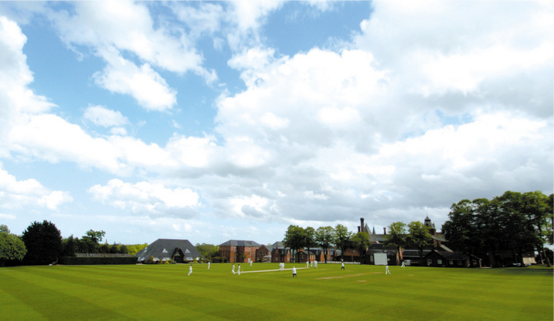

With the rest of the country clogged and waterlogged, the Bedu rode to Framlingham, for an all day game in perfect conditions.
There they found an outfield smooth and even enough to play lawn tennis on (they do), a wicket so true it could be quested for, and hosts who matched warm hospitality with highly contested cricket.
110 overs were bowled, over 500 runs scored for 15 wickets, with the game in the balance to the end. Along the way, a strong case was made for all-day cricket:
1: Room to attack
The length of the game puts an emphasis on wickets over runs. The Bedu responded with increasingly attacking fields, as Juneed Asad, Andy Browne and Carmen Maputana bowled aggressively. With the bat, Cook (80*) and Bridgestock (62) for Quilibets, and Sharland (61) and Marston (58) all took time to get themselves in before launching attacks of their own.
2: Every ball is an event
Dermot Reeve’s mantra was that the next ball could change the course of the game, focus on it. Three times in the opening 10 overs Asad and Browne found the edge; three times the nick went down. Crucial? 100 overs later, Bedouins need 14 to win, 9 wickets down. Juneed gets the fraction of width he is looking for, times the ball sweetly behind square, a sure four to release the pressure. But Mark Keetch is switched on for Quilibets, dives full length from point and stops the ball. No run. Critical?
3: Time to regroup
In an all day game, each innings is divided into two sessions. There is not only time to recover, but the opportunity to regroup. 97 for 3 from 32 overs at lunch, Quilibets transformed their innings after it. The running was more positive, the batting more confident. Where the ball had been on top, suddenly the slightest error by the bowlers was punished with a boundary.
4: the 4th Dimension of Captaincy
Beyond strategies for batting, bowling and fielding, an all day game brings in the element of time. The option to keep on batting allowed Quilibets to recover from a slow start. Captain Halliday kept the innings going past the 60 over mark so that Bridgestock, Cook and Sayer could take Quilibets to 260. For his part, the Bedouin captain Harrison kept the over rate brisk so his side would still have 52 overs back.
5: Longer, but more intense
Instead of being in the field for 40 or 50 overs, each team is in action for two two hour bursts, with proper rest between. In the last session, with the Bedu apparently set for a win, Quilibets dug deep and a refreshed Tom Bosher came back for a second hostile spell.
6: Platform for inspiration
25 overs into the first session, with three catches behind the wicket already down, Mears looked well set for Quilibets on 34. Carmen approached the wicket, the ball was skiddy, late swing, then, faster than eyes could track it a nick off bat, a flick off Matt Holly’s outstretched glove, diverting again without losing pace to be caught, wonderfully, faster than the brain could keep up with, by the tumbling Sandy Balfour at first slip. He had reacted to the first nick and, incredibly, his hands adjusted to the second diversion across only a few feet. Electric.
The inspiration for Quilibets was less zap, more grunt. It came in the strong, skilful shape of Tom Bosher. He had taken two wickets with the new ball, bowling big outswing. At the end he came back, attacking the stumps with off-cutters. Against him, Holly (22), Rawson (15) and Browne all fought to steer the Bedu home. Murray fell, and finally it was Browne and Asad, Bedu’s 10th wicket pair, needing 27 for the win.
On the boundary, players and spectators were gripped. Spines tingled, teeth clenched, legs crossed and uncrossed. Carefully, the Bedu pair worked their way towards the target. Picking up singles but unable to hit the boundaries to release the pressure. Mark Keetch made his crucial interception in the field and Bosher got the next delivery straighter and seaming back to win the game with 8 for 59.
He was the Quilibets man of the match, with Richard Marston winning the honour for the Bedouin for his aggressive runs. Players, officials and spectators all headed for the Station Tavern, to reflect on the game and look forward to a rematch.
There they found an outfield smooth and even enough to play lawn tennis on (they do), a wicket so true it could be quested for, and hosts who matched warm hospitality with highly contested cricket.
110 overs were bowled, over 500 runs scored for 15 wickets, with the game in the balance to the end. Along the way, a strong case was made for all-day cricket:
1: Room to attack
The length of the game puts an emphasis on wickets over runs. The Bedu responded with increasingly attacking fields, as Juneed Asad, Andy Browne and Carmen Maputana bowled aggressively. With the bat, Cook (80*) and Bridgestock (62) for Quilibets, and Sharland (61) and Marston (58) all took time to get themselves in before launching attacks of their own.
2: Every ball is an event
Dermot Reeve’s mantra was that the next ball could change the course of the game, focus on it. Three times in the opening 10 overs Asad and Browne found the edge; three times the nick went down. Crucial? 100 overs later, Bedouins need 14 to win, 9 wickets down. Juneed gets the fraction of width he is looking for, times the ball sweetly behind square, a sure four to release the pressure. But Mark Keetch is switched on for Quilibets, dives full length from point and stops the ball. No run. Critical?
3: Time to regroup
In an all day game, each innings is divided into two sessions. There is not only time to recover, but the opportunity to regroup. 97 for 3 from 32 overs at lunch, Quilibets transformed their innings after it. The running was more positive, the batting more confident. Where the ball had been on top, suddenly the slightest error by the bowlers was punished with a boundary.
4: the 4th Dimension of Captaincy
Beyond strategies for batting, bowling and fielding, an all day game brings in the element of time. The option to keep on batting allowed Quilibets to recover from a slow start. Captain Halliday kept the innings going past the 60 over mark so that Bridgestock, Cook and Sayer could take Quilibets to 260. For his part, the Bedouin captain Harrison kept the over rate brisk so his side would still have 52 overs back.
5: Longer, but more intense
Instead of being in the field for 40 or 50 overs, each team is in action for two two hour bursts, with proper rest between. In the last session, with the Bedu apparently set for a win, Quilibets dug deep and a refreshed Tom Bosher came back for a second hostile spell.
6: Platform for inspiration
25 overs into the first session, with three catches behind the wicket already down, Mears looked well set for Quilibets on 34. Carmen approached the wicket, the ball was skiddy, late swing, then, faster than eyes could track it a nick off bat, a flick off Matt Holly’s outstretched glove, diverting again without losing pace to be caught, wonderfully, faster than the brain could keep up with, by the tumbling Sandy Balfour at first slip. He had reacted to the first nick and, incredibly, his hands adjusted to the second diversion across only a few feet. Electric.
The inspiration for Quilibets was less zap, more grunt. It came in the strong, skilful shape of Tom Bosher. He had taken two wickets with the new ball, bowling big outswing. At the end he came back, attacking the stumps with off-cutters. Against him, Holly (22), Rawson (15) and Browne all fought to steer the Bedu home. Murray fell, and finally it was Browne and Asad, Bedu’s 10th wicket pair, needing 27 for the win.
On the boundary, players and spectators were gripped. Spines tingled, teeth clenched, legs crossed and uncrossed. Carefully, the Bedu pair worked their way towards the target. Picking up singles but unable to hit the boundaries to release the pressure. Mark Keetch made his crucial interception in the field and Bosher got the next delivery straighter and seaming back to win the game with 8 for 59.
He was the Quilibets man of the match, with Richard Marston winning the honour for the Bedouin for his aggressive runs. Players, officials and spectators all headed for the Station Tavern, to reflect on the game and look forward to a rematch.
View the Scorecard
